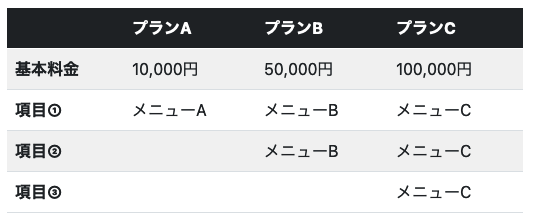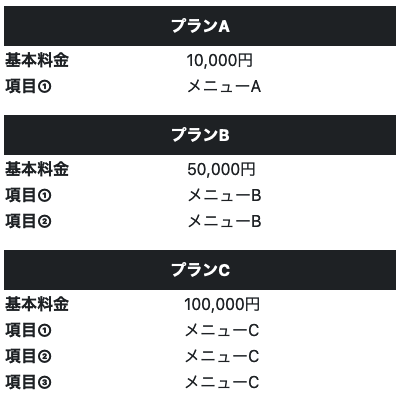tableタグのレスポンシブ対応は毎度工夫が必要だと感じています。
何度かtableのレスポンシブ対応例は投稿しているので、もしよろしければ他の記事もご覧ください。
今回は、料金表のような比較表をスマホサイズでも横スクロールなしで表示する事例を紹介いたします。
仕様と表示例
まずは完成イメージです。
以下がPCモニターでの表示イメージです。
プラン別の料金比較表を想定しています。
次にSPモニターでの表示イメージです。
- PCは横並び/SPは縦並び
- SPは非対応の項目(空白のセル)は表示しない
という仕様になります。
項目数が多かったりテキスト量が多いケースでは、こちらの方がすっきりして見やすいかもしれません。
実装
HTML
html側にはPC用の横並び表しか記述しません。
SP用のコードはJavaScriptで動的に挿入します。
そのため、SP用tableを挿入する箇所をID指定する必要があります。
<!-- bootstrapのclass名を記入していますが、class名は任意です -->
<table class="table table-striped">
<thead class="table-dark">
<tr>
<th></th>
<th>プランA</th>
<th>プランB</th>
<th>プランC</th>
</tr>
</thead>
<tbody>
<tr>
<th>基本料金</th>
<td>10,000円</td>
<td>50,000円</td>
<td>100,000円</td>
</tr>
<tr>
<th>項目①</th>
<td>メニューA</td>
<td>メニューB</td>
<td>メニューC</td>
</tr>
<tr>
<th>項目②</th>
<td></td>
<td>メニューB</td>
<td>メニューC</td>
</tr>
<tr>
<th>項目③</th>
<td></td>
<td></td>
<td>メニューC</td>
</tr>
</tbody>
</table>
<!-- SP用tableを挿入する箇所 -->
<div id="resTable"></div>
PC用tableの<thead>からプラン名を、<tbody>内<td>からテキストをそれぞれ取得するので、各タグは省略せず記述してください。
JavaScript
.tableというclass名はHTMLの<table>に指定したclass名に書き換えてください。
const resTable = document.getElementById('resTable'); // tableを挿入するdivを指定
const arrayMenu = [];
// 項目名を取得し配列に追加
document.querySelectorAll('.table > tbody > tr').forEach(function(menuName, index) {
arrayMenu.push(menuName.children[0].innerHTML);
});
// 各プランの処理
document.querySelectorAll('.table > thead th').forEach(function(planName, index) {
if (index > 0) { // 空白セルを無視
const planTableSP = document.createElement('table');
planTableSP.classList.add('table', 'table-striped'); // tableに追加するclass名。不要なら無しでOK
const planClass = planName.getAttribute('class');
// プラン名を挿入
const tHead = document.createElement('thead');
const tRow = document.createElement('tr');
const thCell = document.createElement('th');
tHead.classList.add('table-dark'); // 「プラン名」の<thead>に追加するclass名。不要なら無しでOK
thCell.setAttribute('colspan', '2');
thCell.classList.add(planClass, 'text-center'); // 「プラン名」の<th>に追加するclass名。不要なら無しでOK
thCell.innerHTML = planName.innerHTML;
tRow.appendChild(thCell);
tHead.appendChild(tRow);
planTableSP.appendChild(tHead);
// tbody生成
const tBody = document.createElement('tbody');
// 各項目の処理
document.querySelectorAll('.table > tbody > tr').forEach(function(row, rowIndex) {
const menuRow = document.createElement('tr'); // tr生成
const menuCell = document.createElement('th'); // th生成
menuCell.innerHTML = arrayMenu[rowIndex];
// 空白の項目は無視
if (row.children[index].textContent !== '') {
const menuContent = document.createElement('td'); // td生成
menuContent.innerHTML = row.children[index].innerHTML;
// trにth/tdを追加
menuRow.appendChild(menuCell);
menuRow.appendChild(menuContent);
// tableにtrを追加
planTableSP.appendChild(menuRow);
} // if
}); // forEach
// 指定divに生成したtableを挿入
resTable.appendChild(planTableSP);
} // if
});
これでページを表示すると、元のPC用tableの下に動的に追加されたSP用のtableも表示されているのを確認できると思います。
あとは端末別に適切に表示すればいいので、JavaScriptなりCSSなりで対応しましょう。
力技ではありますが、ユーザーに適切に情報を届けることが優先されるべきなので、必ずしもCSSだけでレスポンシブ対応する必要は無いと思っています。
何かの参考になりましたら幸いです。

